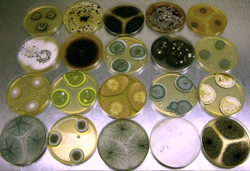Mold allergy occurs when someone inhales spores from molds in the environment. The spores trigger allergy and asthma symptoms in those people who are allergic to that specific type of spore.

Molds grow indoors and outdoors, in all kinds of weather, and all year long. Mold allergy symptoms may worsen from July to late summer when the spores are spread by the wind. However, there is no "mold season" as occurs with pollen allergies.
Mold counts can change quickly with the weather. Certain spore types reach peak levels in dry, breezy weather. Some need high humidity, fog or dew to release spores. This group is abundant at night and during rainy periods.
Many molds grow on rotting logs and fallen leaves, in compost piles and on grasses and grains. Unlike pollens, molds do not die with the first killing frost of winter. Most outdoor molds become dormant during the winter. In the spring they grow on vegetation killed by the cold.
Although there are many types of molds, only a few are responsible for most cases of mold allergy. The different spores can be identified when viewed under a microscope or when grown.
The molds more responsible for causing allergy symptoms include the following:
- Alternaria
- Cladosporium (Hormodendrum)
- Aspergillus
- Penicillium
- Helminthosporium
- Epicoccum
- Fusarium
- Mucor
- Rhizopus
- Aureobasidium (pullularia)
A person may be allergic to one or more type of mold spores.
What causes mold allergy?
The inhaled spores are seen as a foreign invader by the body's immune system, which responds by releasing histamines. Histamines cause allergic symptoms like itchy and watery eyes, sneezing, and coughing.
Those at most risk for mold allergy including people with a family history of allergies, people who work around mold (such as farmers, loggers, or bakery workers), and people who live in damp, humid homes, such as those with leaky basements.
What are the symptoms of mold allergy?
The symptoms of mold allergy are similar to those of other allergies and include:
- Allergic conjunctivitis causing itching, burning and watery eyes
- Allergic rhinitis causing sneezing, nasal congestion and runny nose
- Sinus inflammation (sinusitis)
- Skin rash, including hives
- Worsening asthma symptoms in those with asthma
How is mold allergy diagnosed?
To distinguish mold allergy from other types of allergies, your doctor will start by collecting information about your symptoms, as well as you family history. For the most accurate diagnosis, your doctor may order a skin test or blood allergy test, which detects allergic sensitivity to certain substances.
How is mold allergy treated?
As with other types of allergies, the primary goal is to avoid exposure to the offending substance.
In cases where exposure has already occurred, treatment is focused on alleviating allergy symptoms. Treatment options include:
- Antihistamines (Claritin®, Allegra®, Xyzal®, Zyrtec®) to reduce itching, nasal congestion, sneezing watery eyes.
- Nasal sprays (Flonase, Nasonex) to reduce sneezing and nasal congestion.
- Eye drops, including ocular antihistamines, to reduce eye itching burning and watering.
- Decongestants
- Inhaled corticosteroids (Asmanex®, Advair®, Flovent® to control asthma symptoms that may occur
Immunotherapy (allergy shots) may be recommended for individuals with chronic symptoms of mold allergies that are not well controlled with allergy medications. Allergy shots requires a series of allergy shots over months or years to desensitize the body to the specific mold spore that triggers allergy symptoms.
How can mold allergy be prevented?

Molds are everywhere. Indoor molds are found in dark, warm, humid and musty environments such as damp basements, cellars, attics, bathrooms and laundry rooms. They are also found where fresh food is stored, in refrigerator drip trays, garbage pails, air conditioners and humidifiers.
Outdoor molds grow in moist shady areas. They are common in soil, decaying vegetation, compost piles, rotting wood and fallen leaves.
The National Institute for Environmental Sciences, a division of the National Institutes of Health, recommends these preventative strategies for people suffering from mold allergies:
- Use a dehumidifier or air conditioner to maintain relative humidity below 50% and keep temperatures cool.
- Vent bathrooms and clothes dryers to the outside, and run bathroom and kitchen vents while bathing and cooking.
- Regularly check faucets, pipes and ductwork for leaks.
- When first turning on home or car air conditioners, leave the room or drive with the windows open for several minutes to allow mold spores to disperse.
- Remove decaying debris from the yard, roof and gutters.
- Avoid raking leaves, mowing lawns or working with peat, mulch, hay or dead wood. If you must do yard work, wear a mask and avoid working on hot, humid days.
Source: Vivacare
Last updated : 6/27/2020